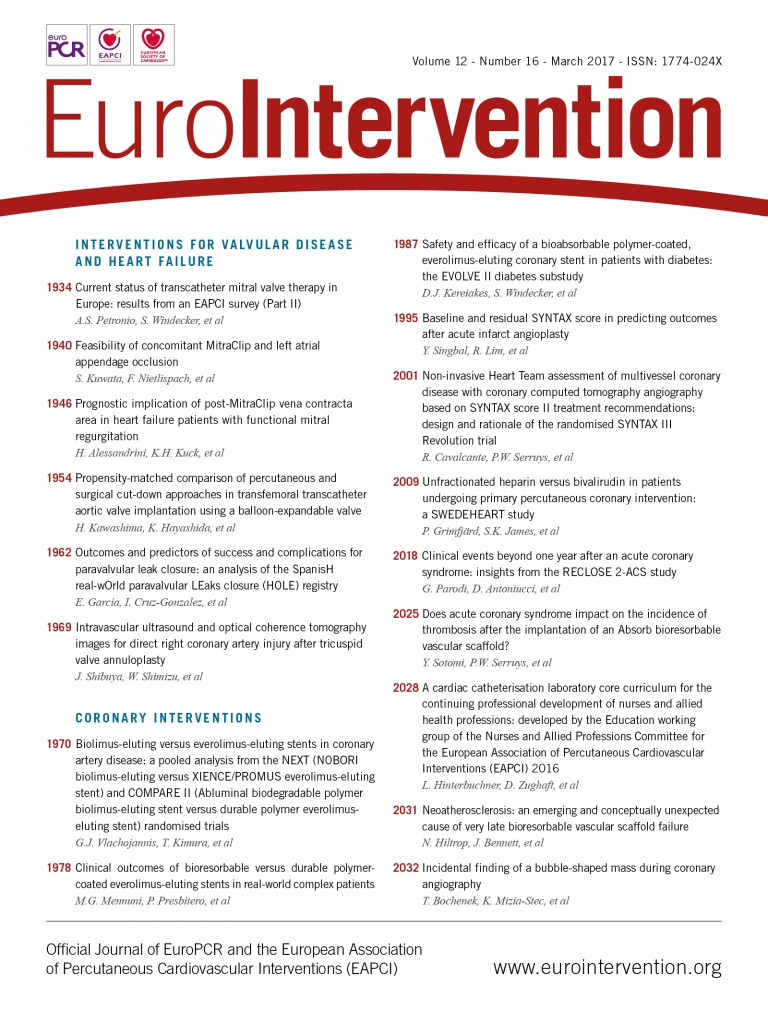
Potent adjunctive parenteral anticoagulants in addition to dual antiplatelet therapy are recommended for the treatment of ST-elevation myocardial infarction (STEMI) with primary PCI (PPCI) in recent guidelines. While unfractionated heparin (UFH) is given to the majority of STEMI patients undergoing PPCI worldwide, the low molecular weight heparin enoxaparin and the direct thrombin inhibitor bivalirudin are less frequently used, which is also based on the current European Society of Cardiology (ESC) revascularisation guidelines that recommend the use of UFH with a class IC, of bivalirudin with a class IIaA, and enoxaparin with a class IIaB recommendation, respectively1. Bivalirudin was even downgraded compared to the 2012 ESC STEMI guidelines2 when it still had a class IB recommendation based on mortality and bleeding benefits over UFH in combination with glycoprotein IIb/IIIa receptor inhibitors (GPIs), despite an increased stent thrombosis (ST) rate3-5. This downgrade was partially due to uncertainties concerning the mortality benefit that was not seen in other trials and also with respect to the bleeding benefit, which was mainly attributed to the more frequent use of GPIs in the UFH arm6.
Several subsequent publications seem to support a reduced use of bivalirudin. The only trial that compared UFH with bivalirudin, adding GPIs in bail-out situations only, the open-label, single-centre HEAT-PPCI trial, showed a lower rate of major adverse ischaemic events with UFH, including acute and subacute ST (at 30 days), and also demonstrated a tendency for less bleeding under UFH7. A potential explanation for the latter could be the prominent use of the new and more effective P2Y12 receptor inhibitors in the trial that are known to be associated with significantly higher spontaneous bleeding rates8. Other trials and meta-analyses have shown no mortality differences between UFH (with or without GPIs) and bivalirudin, an increased early ST rate for bivalirudin, but also a lower bleeding risk9-13.
In a pre-specified post hoc analysis of the EUROMAX trial, bivalirudin reduced the rate of per protocol major bleeding compared to patients treated with UFH alone14. Similar results were obtained when the EUROMAX and HORIZONS trials were analysed together15. In a post hoc analysis of the EUROMAX trial, the authors were able to show that a prolonged infusion of bivalirudin in the PCI dosage is capable of reducing early ST rates, as seen with other trials16. Indeed, the early ST rate in bivalirudin users was acceptably low in registry studies reflecting a real-world situation17,18 and also in the BRIGHT trial, which in part may be attributed to the strategy of prolonged bivalirudin infusion after PPCI19. In a meta-analysis of randomised trials and registries of bivalirudin monotherapy versus UFH monotherapy in more than 32,000 patients undergoing PCI for different indications, bivalirudin was associated with a significant 42% reduction in mortality20. A recent meta-analysis of 14,095 STEMI patients undergoing PPCI in randomised trials showed that bivalirudin as compared to UFH with or without GPI reduced the risk of all-cause mortality, cardiac mortality and major bleeding, but yielded comparable rates of major adverse cardiac events and net adverse clinical events at 30 days21. A recent UK registry report of more than 61,000 PPCI patients treated with either UFH/GPI or bivalirudin could not detect any mortality advantage with bivalirudin but found a higher mortality in patients treated with UFH only22.
In this issue, Grimfjärd et al present the data of the SCAAR registry, which compared ST, reinfarction, stroke, all-cause mortality and major bleeding in a large contemporary Swedish PPCI population treated with either UFH only or bivalirudin (with or without concomitant UFH)23. These authors demonstrated low and similar rates of early ST in UFH or bivalirudin-only treated STEMI patients undergoing PPCI. Most importantly, mortality was significantly higher in patients receiving UFH only compared with bivalirudin-only treated patients and there were no differences in major bleeding, reinfarction or stroke between the treatment arms. Although it is believed that interventional cardiologists in Sweden perform PPCI in close accordance with guideline recommendations, which would include the choice of the optimal dosages of UFH and bivalirudin during intervention and the prolongation of bivalirudin infusion up to four hours in the PPCI dosage, these data have unfortunately not been presented, which is an important limitation of the current analysis.
Are uncertainties answered sufficiently?
So far, the comparison of UFH and bivalirudin with respect to clinical outcomes (mortality, ST, bleeding) has been hampered by the fact that a mix of planned (preferably in the UFH arms of trials) and bail-out GPI use limited the interpretation of results. Recent meta-analyses, including studies with a more balanced use of GPIs (mainly in bail-out situations) have demonstrated no mortality benefit but acceptably low early ST rates and fewer bleeding complications in bivalirudin users. Only the well-performed but single-centre and open-label HEAT-PPCI trial reported advantages exclusively in favour of UFH but did not use the optimal prolonged bivalirudin infusion, which has been criticised as it showed a reduction of early ST rates without increasing severe bleeding. The recent data from the SCAAR registry compared a strategy with UFH only vs. bivalirudin only treatment and point again in the direction of a significant mortality benefit and a tendency for less bleeding in bivalirudin-treated patients with low early ST rates in both arms. These data seem to reflect optimal real-world care for STEMI patients undergoing PPCI. The only drawback is the fact that dosing strategies have not been effectively collected and that it is only assumed that treatment recommendations have been followed accordingly. Nevertheless, these data are sufficient for bivalirudin to regain an important role as a parenteral anticoagulant in STEMI patients undergoing primary PCI and might eventually lead to a change of recommendation of bivalirudin in future guidelines.
Conflict of interest statement
K. Huber received honoraria for speaker activities from The Medicines Company. F.W.A. Verheugt received honoraria for advisory board and speaker activities from The Medicines Company.

